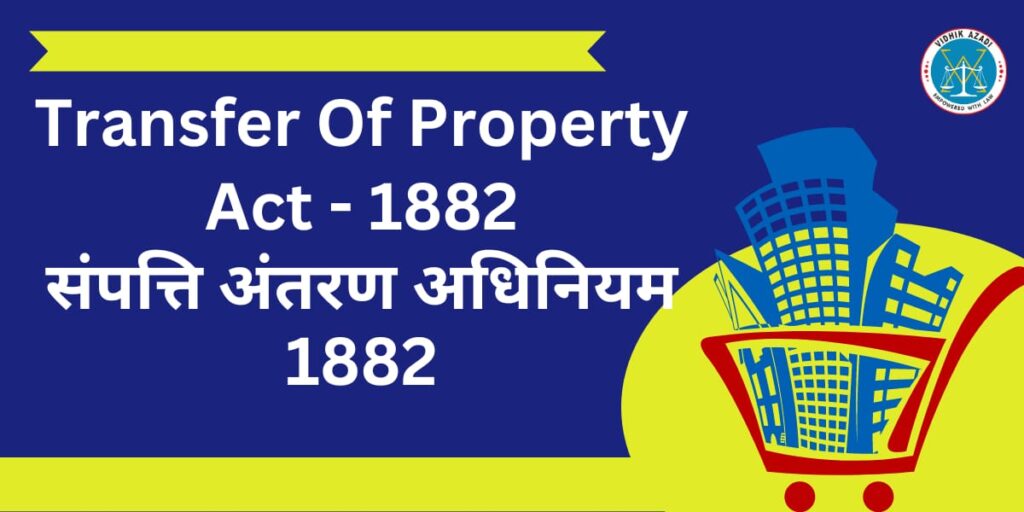Transfer of Property Act

Transfer of Property Act, 1882
The Transfer of Property Act, 1882 is an important piece of legislation in Indian law that governs the rules and regulations related to the transfer of both immovable and movable properties. Its objective is to provide clarity and organization to the rules governing the transfer of property. The act of conveying property from one person to another, including through sale, gift, exchange, lease, etc. is included in it. Transferor is the person who transfers the property and transferee the person to whom the property is transferred. It specifies that transfer of property must be made by a living person to another living person. What may be transferred – Certain properties and rights cannot be transferred, such as family rights, rights restricted from transfer, etc. Persons competent to transfer – The transferor must be competent and the legal owner of the property and the transfer of property is done along with all its rights and liabilities.
The Doctrine of Part Performance states that if a person has taken possession of property based on an agreement and has fulfilled his obligations, the transferor cannot refuse to honor the agreement. It specifies that the transfer of immovable property through sale must be registered and its value must exceed Rs. 100. It also describes the various types of mortgages and their rules, such as simple mortgage, usufructuary mortgage, mortgage by conditional sale, etc. The mortgagee has the right to sell the mortgaged property if the mortgagor fails to repay the debt on time. Defines Lease that it is an agreement whereby one person gives another person the right to use and occupy the property for a certain period. The lessor must allow the proper use of the property and the lessee must pay the rent on time. Defines a Gift that a gift is a transfer made voluntarily and without consideration and gift of immovable property must be made through registration.
This Act provides clarity on various modes of property transfer and applies rules to them. It ensures the protection of the rights and obligations of all parties involved in the transfer of property. The Act plays a significant role in resolving disputes related to the transfer of property. The Transfer of Property Act, 1882, is a crucial part of Indian property law that standardized various aspects of property transfer. It not only provides legal clarity and structure to property transfers but also ensures that the rights and obligations of all parties involved are clear and protected.
संपत्ति अंतरण अधिनियम, 1882
संपत्ति अंतरण अधिनियम, 1882 भारतीय कानून का एक महत्वपूर्ण अधिनियम है, जो अचल और चल संपत्तियों के हस्तांतरण के नियमों और विनियमों को निर्धारित करता है। इसका उद्देश्य संपत्ति के हस्तांतरण को स्पष्ट और सुव्यवस्थित बनाना है। इस अधिनियम के तहत संपत्ति में चल और अचल संपत्ति दोनों शामिल हैं। हस्तांतरण के तहत किसी व्यक्ति से दूसरे व्यक्ति को संपत्ति के हस्तांतरण में बिक्री, गिफ्ट, एक्सचेंज, लीज़, और अन्य रूप शामिल हैं। संपत्तिधारी वह व्यक्ति है जो संपत्ति का हस्तांतरण करता है जबकि संपत्ति प्राप्तकर्ता वह व्यक्ति जिसे संपत्ति हस्तांतरित की जाती है।
संपत्ति का हस्तांतरण एक जीवित व्यक्ति द्वारा दूसरे जीवित व्यक्ति में कैसे किया जाना चाहिए? क्या-क्या हस्तांतरित किया जा सकता है, कुछ संपत्तियाँ और अधिकार हस्तांतरित नहीं किए जा सकते, जैसे कि पारिवारिक अधिकार, अधिकार जो हस्तांतरण के लिए प्रतिबंधित हैं, आदि। हस्तांतरणकर्ता को सक्षम और संपत्ति का कानूनी मालिक होना चाहिए। संपत्ति का हस्तांतरण उसके सभी अधिकारों और जिम्मेदारियों के साथ किया जाता है। आंशिक निषेध सिद्धांत यह नियम बताता है कि यदि एक व्यक्ति ने एक समझौते के आधार पर संपत्ति का कब्जा प्राप्त किया है और उसने अपनी जिम्मेदारियों को पूरा किया है, तो ट्रांसफरर समझौते का पालन करने से मना नहीं कर सकता, जबकि बिक्री यह बताता है कि बिक्री के माध्यम से अचल संपत्ति का हस्तांतरण तभी वैध होगा जब उसे रजिस्टर्ड किया गया हो और उसका मूल्य 100 रुपये से अधिक हो।
यह बंधक की विभिन्न प्रकारों और उनके नियमों का वर्णन करता है, जैसे साधारण बंधक, सामान्य बंधक, बंधक द्वारा बिक्री आदि। बंधकधारी को यह अधिकार है कि वह बंधक की गई संपत्ति को बेच सकता है यदि बंधककर्ता ने समय पर कर्ज नहीं चुकाया। लीज़ एक ऐसा अनुबंध है जिसके तहत एक व्यक्ति दूसरे व्यक्ति को एक निश्चित अवधि के लिए संपत्ति का उपयोग और कब्जा देता है। लीज़धारी को संपत्ति का उचित उपयोग करना चाहिए और समय पर किराया चुकाना चाहिए। लीज़दाता को संपत्ति को अच्छी स्थिति में बनाए रखना चाहिए। गिफ्ट एक ऐसा हस्तांतरण है जो स्वेच्छा से और बिना किसी मुआवजे के किया जाता है। गिफ्ट का हस्तांतरण पंजीकरण के माध्यम से होना चाहिए यदि वह अचल संपत्ति है।
यह अधिनियम संपत्ति के हस्तांतरण के विभिन्न तरीकों को स्पष्ट करता है और उन पर नियम लागू करता है। यह सुनिश्चित करता है कि संपत्ति के हस्तांतरण में शामिल सभी पक्षों के अधिकारों और दायित्वों की सुरक्षा हो। संपत्ति के हस्तांतरण से संबंधित विवादों के समाधान में यह अधिनियम एक महत्वपूर्ण भूमिका निभाता है। ट्रांसफर ऑफ प्रॉपर्टी एक्ट, 1882, भारतीय संपत्ति कानून का एक महत्वपूर्ण हिस्सा है जो संपत्तियों के हस्तांतरण के विभिन्न पहलुओं को विनियमित करता है। यह अधिनियम न केवल संपत्ति के हस्तांतरण को कानूनी स्पष्टता और संरचना प्रदान करता है बल्कि यह यह सुनिश्चित करता है कि संपत्ति के हस्तांतरण में शामिल सभी पक्षों के अधिकार और दायित्व स्पष्ट और सुरक्षित हों।
